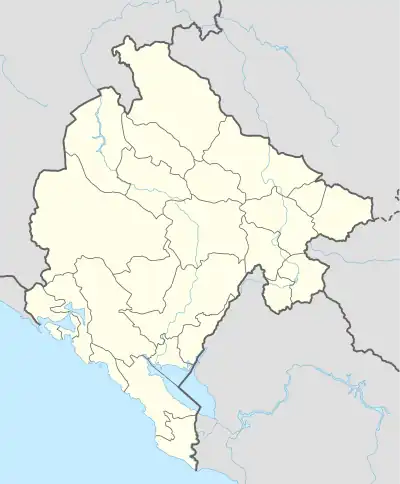Krute
Круте Krythë | |
|---|---|
Village | |
 Krute Location within Montenegro | |
| Coordinates: 42°00′50″N 19°15′40″E / 42.014°N 19.261°E | |
| Country | |
| Municipality | |
| Population (2011) | |
| • Total | 525 |
| Time zone | UTC+1 (CET) |
| • Summer (DST) | UTC+2 (CEST) |
| Car plates | UL |
Krute (Cyrillic: Круте; Albanian: Krythë) is a village in the municipality of Ulcinj, southeastern Montenegro. It is located north-east of Ulcinj town.
Name
Krytha's name has its origin in the medieval Albanian tribe of Kryethi.[1][2] It is alternatively known as Krytha e Katërkollës to differentiate by another village of the same to the north of Ulcinj, Krytha e Ulqinit.
History
Venetian diplomat Mariano Bolizza who travelled in the area in 1614 recorded that it was a Catholic village with 30 households and 75 men-in-arms commanded by Gjur Çeka.[3]
Demographics
| Year | Pop. | ±% |
|---|---|---|
| 2003 | 606 | — |
| 2011 | 525 | −13.4% |
According to Montenegro's 2011 census, Krute has a population of 525.[4] Krute has slightly more men than women; there are 271 men (51.6%) and 254 women (48.4%).[4] A significant portion of the population (439, or 83.6%) is over the age of 15.[4] According to Montenegro's 2011 census, the majority of residents are ethnically Albanian (91.4%) with minority groups of Montenegrins as well as people who identify as Muslim ethnically. A similar majority (91.8%) consider Albanian to be their mother tongue, with the remaining population identifying either Montenegrin (7.2%) or "other" (0.95%) as their mother tongue.[4] Additionally, 521 (99.2%) of the residents practice Islam.[4]
| Ethnicity | Number | Percentage |
|---|---|---|
| Albanians | 480 | 91.43% |
| Muslims | 24 | 4.57% |
| Montenegrins | 16 | 3.05% |
| Other | 5 | 0.95% |
| Total | 525 | 100% |
Notable people
- Basri Çapriqi, poet
References
- ↑ Pulaha, Selami (1975). "Kontribut për studimin e ngulitjes së katuneve dhe krijimin e fiseve në Shqipe ̈rine ̈ e veriut shekujt XV-XVI' [Contribution to the Study of Village Settlements and the Formation of the Tribes of Northern Albania in the 15th century]". Studime Historike. 12: 124. Retrieved 30 January 2020.
- ↑ Gjurmime albanologjike, Seria e shkencave filologjike, vol. 15–16, Prishtina: Instituti Albanologjik i Prishtines, 1986, pp. 107–11, OCLC 475280214
- ↑ Bolizza, Mariano. "Report and Description of the Sanjak of Shkodra". Retrieved 28 January 2020.
- 1 2 3 4 5 "Census 2011 data - Settlements". Statistical Office of Montenegro. Retrieved 16 February 2018.